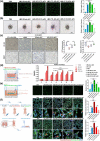Clathrin light chain A-enriched small extracellular vesicles remodel microvascular niche to induce hepatocellular carcinoma metastasis
- PMID: 37606345
- PMCID: PMC10443339
- DOI: 10.1002/jev2.12359
Clathrin light chain A-enriched small extracellular vesicles remodel microvascular niche to induce hepatocellular carcinoma metastasis
Abstract
Small extracellular vesicles (sEVs) play a key role in exchanging cargoes between cells in tumour microenvironment. This study aimed to elucidate the functions and mechanisms of hepatocellular carcinoma (HCC) derived sEV-clathrin light chain A (CLTA) in remodelling microvascular niche. CLTA level in the circulating sEVs of HCC patients was analysed by enzyme-linked immunosorbent assay (ELISA). The functions of sEV-CLTA in affecting HCC cancerous properties were examined by multiple functional assays. Mass spectrometry was used to identify downstream effectors of sEV-CLTA in human umbilical vein endothelial cells (HUVECs). Tube formation, sprouting, trans-endothelial invasion and vascular leakiness assays were performed to determine the functions of sEV-CLTA and its effector, basigin (BSG) in HUVECs. BSG inhibitor, SP-8356, was tested in a mouse model of patient-derived xenografts (PDXs). Circulating sEVs of HCC patients had markedly enhanced CLTA levels than control individuals and were reduced in patients after surgery. HCC derived sEV-CLTA enhanced HCC cancerous properties, disrupted endothelial integrity and induced angiogenesis. Mechanistically, CLTA remodels microvascular niche by stabilizing and upregulating BSG. Last, SP-8356 alone or in combination with sorafenib attenuated PDXs growth. The study reveals the role of HCC derived sEV-CLTA in microvascular niche formation. Inhibition of CLTA and its mediated pathway may illuminate a new therapeutic strategy for HCC patients.
Keywords: clathrin light chain A; hepatocellular carcinoma; intercellular communication; premetastatic niche; small extracellular vesicles; vascular permeability.
© 2023 The Authors. Journal of Extracellular Vesicles published by Wiley Periodicals, LLC on behalf of the International Society for Extracellular Vesicles.
Conflict of interest statement
The authors have declared that no conflict of interest exists.
Figures







References
-
- Biancospino, M. , Buel, G. R. , Nino, C. A. , Maspero, E. , Scotto di Perrotolo, R. , Raimondi, A. , Redlingshöfer, L. , Weber, J. , Brodsky, F. M. , Walters, K. J. , & Polo, S. (2019). Clathrin light chain A drives selective myosin VI recruitment to clathrin‐coated pits under membrane tension. Nature Communications, 10(1), 4974. - PMC - PubMed
-
- Chen, Y. , Zhang, H. , Gou, X. , Horikawa, Y. , Xing, J. , & Chen, Z. (2009). Upregulation of HAb18G/CD147 in activated human umbilical vein endothelial cells enhances the angiogenesis. Cancer Letters, 278(1), 113–121. - PubMed
-
- Escola, J. M. , Kleijmeer, M. J. , Stoorvogel, W. , Griffith, J. M. , Yoshie, O. , & Geuze, H. J (1998). Selective enrichment of tetraspan proteins on the internal vesicles of multivesicular endosomes and on exosomes secreted by human B‐lymphocytes. Journal of Biological Chemistry, 273(32), 20121–20127. - PubMed
-
- Fong, M. Y. , Zhou, W. , Liu, L. , Alontaga, A. Y. , Chandra, M. , Ashby, J. , Chow, A. , O'Connor, S. T. F. , Li, S. , Chin, A. R. , Somlo, G. , Palomares, M. , Li, Z. , Tremblay, J. R. , Tsuyada, A. , Sun, G. , Reid, M. A. , Wu, X. , Swiderski, P. , … Wang, S. E. (2015). Breast‐cancer‐secreted miR‐122 reprograms glucose metabolism in premetastatic niche to promote metastasis. Nature Cell Biology, 17(2), 183–194. - PMC - PubMed
Publication types
MeSH terms
Substances
LinkOut - more resources
Full Text Sources
Medical
Miscellaneous

